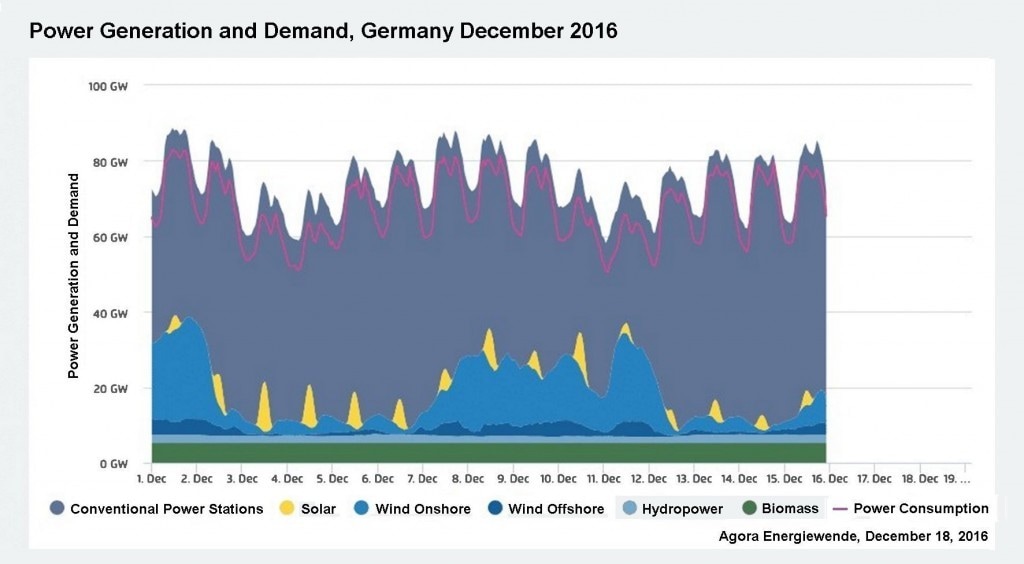|
In this recent blog post I mentioned both California and Germany as sources of the growing evidence of the limits of renewables penetration. This post discussed California. This article on the energy collective which is repost of a German article by Heiner Flassbeck, a prominent and respected German economist discusses the German limits. The graph above from Flassbeck’s article illustrates the problem. It was not necessary for Germany to build this amount of wind and solar to know that periods like December 2016 with low winds and low sunshine are possible. This shows low wind for periods of four to five days. Statistics show that low wind periods of up to two weeks are common in northern Europe. Sunshine in northern Europe is greatly reduced in winter, and weather can reduce it even more. Flassbeck uses this practical evidence to discuss the economic impracticality of the current German path to a completely renewables based energy supply. Fassbeck’s concluding thoughts get to the heart of the issue. I quote: “The example of Energiewende once again demonstrates that the traditional political approaches of our democracies are ill-equipped to solve such complex problems. Consequently, they pursue what I have recently called symbolic politics: democracies do something that is supposed to point in the right direction without thinking it through and without even taking note of the system-related consequences. If it goes wrong, the political predecessors were guilty and nobody feels responsible. That is why citizens need to remain vigilant and critical. You can wish for a lot and always hope for a good outcome. But as important as wishes and hopes are, they are not yet solutions. We likewise have to use our minds when we would prefer to turn them off because the conclusions are so depressing.” In previous posts I have stated my opinion that StratoSolar will not receive attention until current wind and solar actually are shown to be impractical solutions. Perhaps the emerging practical evidence from California and Germany will start to build that awareness. By Edmund Kelly
Comments
PV is not a free market. It is dominated by China and the peculiarities of the Chinese economy. China is both the largest manufacturer and the largest consumer of PV. This has all occurred extremely rapidly over about the last five years. 2017 appears to potentially be a year of reckoning for PV, as this blog article neatly summarizes. The total historical PV cumulative installed capacity is about 300GW, most of it installed over the last few years. 2016 Installed capacity alone was about 70GW, with about 30GW of that in China. US installed a record 12GW in 2016, driven by the potential expiration of subsidy incentives. Most projections have 2017 world PV installations falling well below the 2016 70GW due to reductions in China and the US, with no major new growth area to compensate.
These reductions stem in part from the limited ability of electricity grids to absorb PV. The long-term limit is based on the capacity factor limit of grids to absorb intermittent sources. We are far from this limit, but short term constraints are showing up at very low levels of PV penetration. China’s current limit is the lack of long distance transmission capacity to take the power from the deserts in the west to the users in the east. As discussed in this blog post, California is hitting problems due to the inability of fossil generation to ramp up and down quickly enough to compensate for rapidly changing PV generation as the sun sets. Advocates for PV are focused on the falling cost of PV generation and seem to assume that once PV becomes the lowest cost of generation the world will magically switch to solar energy. The reality is far from this rosy scenario. The real cost of PV electricity will increasingly have to factor in the additional costs needed to incorporate it into the electricity supply system. California is showing the need for storage at very low levels of penetration and China is showing the need for long distance HV-transmission. Both technologies are expensive and in need of development, particularly electricity storage. They are both additions to the current grid and both exceed the cost of PV generation. Add to this the geographical variability of solar, particularly at northern latitudes and the economic case for solar to be a large scale, economically viable supplier of electricity is far in the future. StratoSolar is low cost generation with low cost, fast response storage built in and no need for long distance transmission. It has no daytime intermittency problem and it works well at northern latitudes. It needs relatively minor short term development to prove its viability. In contrast, the storage and HVDC transmission technologies needed to make ground PV viable are in many ways more speculative, unproven and longer term than StratoSolar. By Edmund Kelly |
Archives
December 2023
Categories
All
|
|
© 2024 StratoSolar Inc. All rights reserved.
|
Contact Us
|


 RSS Feed
RSS Feed